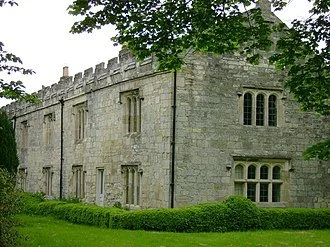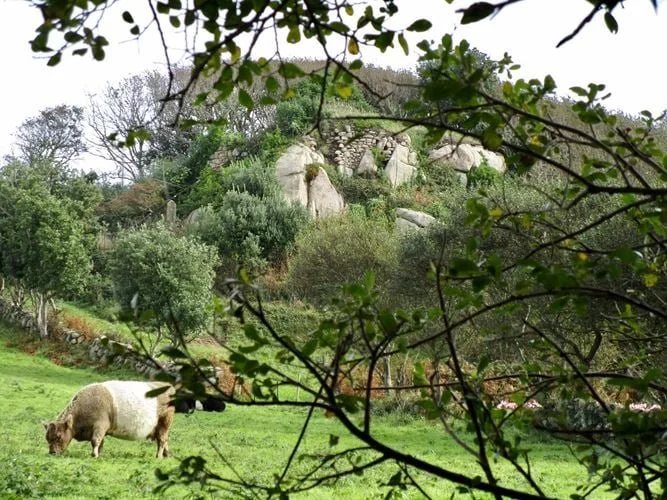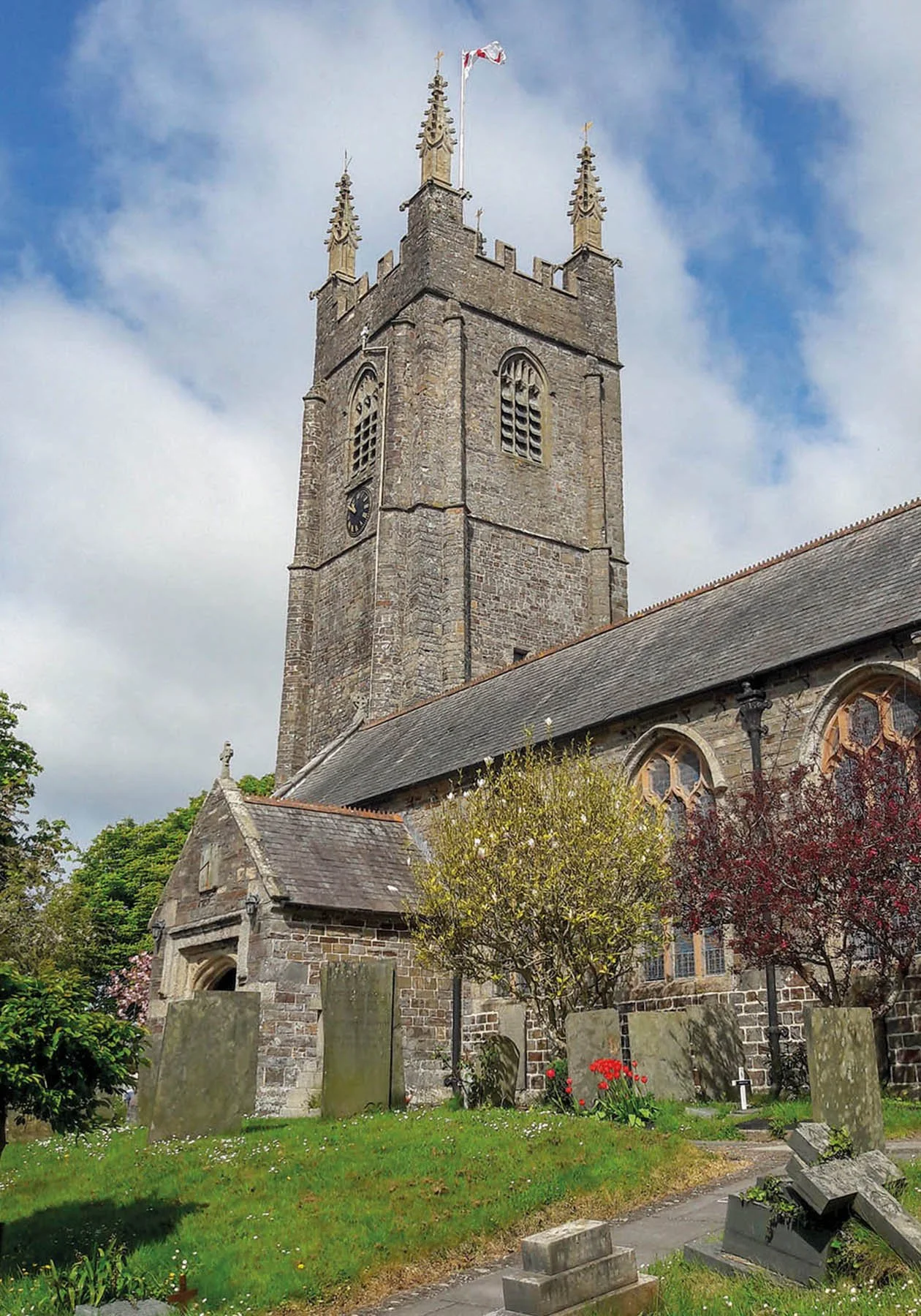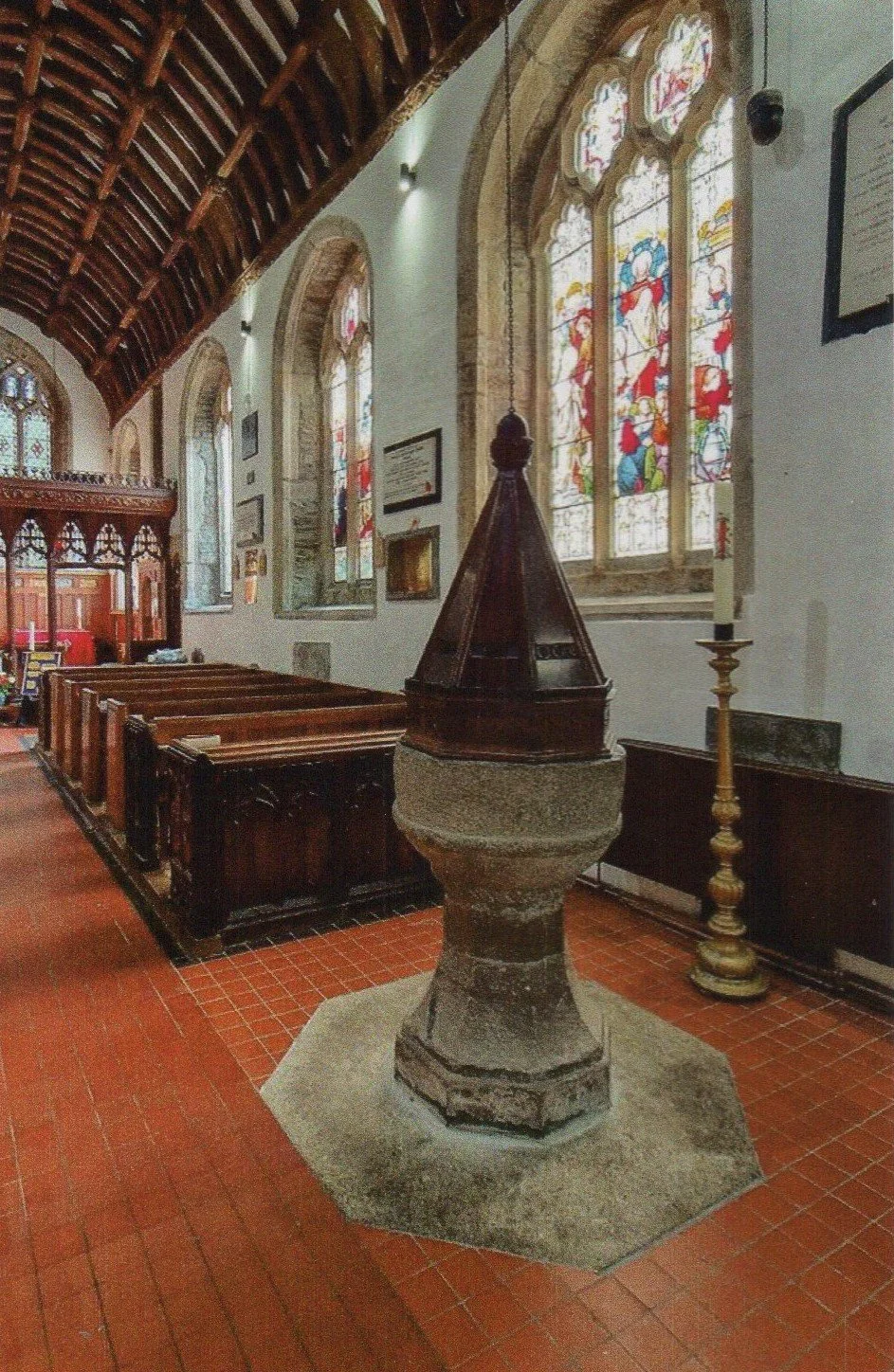The Blanchminster Story
No history of Stratton, Week Saint Mary or Bude would be complete without reference to the Blanchminster family of Binhamy or Bien Amie; a moated crenellated manor house between Bude and Stratton.
Their story has all the traits of ancient aristocratic ancestry, that is, a confusion of names; a mix of spellings of the names; plus, marriage within all the leading families of the time. The Blanchminsters do not disappoint in this respect. There are so many different spellings of the name and many of the family males are called Ralph, Ranulph or Reginald and just to complicate the story further Reginald is sometimes named Ralph, certainly in Hawker’s poem that will follow.
The Blanchminster story connects with all the grand families of Stratton and Bude including the Grenville family of Stowe and the Arundell and Heritz Familes of Ebbingford Manor.
However, of all the aristocratic families connected with our heritage it is perhaps the families of Lucy Toret and her brother Bartholomew, and her husband to be, William Fitz Ralph de Blanchminster, represent the most significant arrivals and whilst we remember the Blanchminsters as great benefactors to Stratton and Bude, it is arguable that the money came through the Lucy Toret family connection. (The name Toret is sometimes spelt Turet and we will use this former spelling in connection with Stratton.)
The family of Lucy Turet has a heritage going back to Saxon times. Her grandfather was Bertram Haget 11, a wealthy Yorkshire magnate and benefactor. He had two sons, and 4 known daughters, one of whom was a Lucia Haget, born 1145 AD at Healaugh, Wetherby, Yorkshire. Bertram Haget is understood to have built the Priory at Healaugh (shown) and it would appear one of his daughters became one of the incumbents.
Lucia married Peter Fitz Toret (c 1165) of Morton Toret (later called Moreton Corbet.). The Toret family were Saxon Lords who had managed to keep their estates at the time of the Norman Conquest, and they inherited the Saxon fortified earthwork at, the then, Moreton Toret, where they built a fortified home with a wood palisade.
Lucia and Peter Fitz Toret had a son Bartholomew (born c1165 - died 1235.) and a daughter Lucy, (born 1177 AD.) Bartholomew, in 1216 rebelled against King John in the First Bishops War, following the forced signing of Magna Carta. Bartholomew was eventually captured and imprisoned, but King John died during 1216 and his son, King Henry 111 came to the throne. A year later, with the new King on the throne, Bartholomew abandoned the cause of the rebels and gave his allegiance to new King; he was duly released from prison.
Shown are the present day remains of the Moreton Toret Castle. Here it is a stone structure, at Lucy’s time it will have been a wooden palisade enclosure.
Daughter Lucy Turet married William Fitz Ralph de Blanchminster in 1198 at Whitchurch, Shropshire; Lucy was aged 21 and Ralph de Blanchminster was around 43 years. The couple moves to Stratton or possibly at Week St Mary and certainly eventually, at the manor of Binhamy, which they will develop and encircle with a moat and palisade.
The Blanchminster family issue from Whitchurch, which was just to the north of Moreton Toret, so this would surely account for the couple coming together. The Latin name for Whitchurch was Album Monesterium and from this we see how Ralph Blanchminster often titled himself, “Ranulph de Albo Monesterio”. The couple had three boys: Roger (b) 1200, William (b) 1205 and Ralph or Ranulph (b) 1210. The family tree as presently understood is shown.
Lucy’s son, as Sir Ranulph, eventually marries Isabella de Wyke, in the second half of the 13th century. This is the family we met earlier from Week St Mary, and this estate now came into the possessions of Sir Ranulph. Either at that time, or a little later, Isabella inherits the estate on the Isles of Sicily, and this too becomes Blanchminster property.
It would seem that Sir Ranulph and Isabella, now improved the defences on the island which may have included defences around Ennor Castle. The norther parts of the island were administered by Tavistock Abbey, but the Old Town was controlled by a more secular administration. There was a history of piratical attacks on the island, so defences of some kind would be welcome. The first mention of a castle at Ennor on south main island was in 1244.
Shown are all that remains of the castle on the Isles of Scilly.
Sir Ranulph and Lady Isabella had a son Reginald, born at Stratton in the year 1245 and he will become Sir Reginald de Blanchminster the Crusading Knight, who eventually married Lady Robin, around 1260. Sir Reginald and Lady Robin had their first son around 1262 to 1265, and he becomes the second Sir Ranulph de Blanchminster; a second son also named Reginald died.
This second Sir Ranulph de Blanchminster married Mirabella de Aspale (Wake) and had at least three girls, no male heirs. Documents around 1306 now identifies him as the owner of the Castle Ennor, Isles of Scilly and nine years later, 1315, he sought the King’s licence to crenellate the castle. Despite his endeavours, however, the castle is held in the name of the newly created Duchy of Cornwall by 1337. It is possible that Sir Ranulph had anticipated this as, in 1335, he had sought permission from Edward 111 to crenellate his manor at Binhamy.
The artwork shows an impression, created for the author, of what the moated manor how would look like following the 1335 work. Beyond is the river Neet estuary which, at that time, was capable of accommodating coastal shipping.
This picture shows the moat today, rather overgrown and neglected. Hopefully to be cleaned up in the near future.
Towards the end of his life, Sir Ranulph engages Richard Bode, the then vicar of St Andrew’s Church at Stratton, as executor of his will in which he leaves a fund to maintain the fabric of the church; to provide armour for the local militia and alms for the poor of the community. It is this set of bequests that forms the basis, or the basic philosophy behind, what in the late 18th century become known as the Blanchminster Charity.
The picture shows the modern day church at Stratton.
The wonderful modern day interior of the church at Stratton where an effigy of Sir Ranulph in Knights armour rests recumbent.
A note on the Blanchminster Trust.
Although the Trust bears the name o the Blanchminsters there appears to be no real evidence to support the idea that he was the sole benefactor- if at all. He is known to have given some lands but not a large monetary donation. In the Blanchminster Trust Records, page 36a entitled “Founders of the Charity” five contributors are listed. The Grenvilles are also stated within 18th century records as having contributed land, if not money. The other point to make is that the Blanchminster Charity is not known by any particular name until the late 18th century. Nevertheless, this Charity has done, and continues to offer, great support towards advancement of business enterprise, education and welfare to the community for more than 600 years. Sir Ranulph died in the year 1348.
The image shows an effigy of a knight in the traditional crossed-leg posture within the church at Stratton. Possibly that o Sir Reginald; was it created by his son, the last Blanchminster, Sir Ranulph?
Sir Reginal, The Crusades and the Adulterous Wife?
So that is the background story of the Blanchminsters. However, the story would not be complete if we did not enlarge on the woes of Sir Reginald de Blanchminster. He married Lady Robin around 1260 and by 1262-65 had one surviving son; that is the last Sir Ranulph.
But Sir Reginald was troubled during his life, as he was driven by his conscience to participate in the Crusade, doing as so many others by joining in the fray with Prince Edward. He deliberates for many years but finally his mind is made up and he sets forth in 1270 to join Prince Edward, on what is known as the 8th Crusade. The army sets sail for Palestine only to find that the French King had signed a peace treaty and he and Prince Edward and his crusading army were forced to return to Sir Reginald’s estate in Scilly.
The Crusaders were hoping that the Phillip 111 of France would soon succeed to the throne and battles would recommence. Phillip however, ever never did decide to engage in battle and Prince Edward and his followers were forced to join with other Christian forces to continue the fight alone. The newly formed army finally landing at Acre on the 9th of May 1271.
(See the map of the perambulations of what became known as the 9th Crusade, courtesy of Wikipedia)
Jerusalem had fallen in 1244 and Acre was now the main centre of the Christianity. Reginald and his fellow crusaders were an important addition to the garrison at Acre, but they stood little chance against the Muslim superior forces, and they soon realised that their position was increasingly desperate, by the middle of 1272 they had seen the Cypriot army join forces against them and Edward signed a ten-year truce. Prince Edward then returned to the Isles of Scilly on 21st November 1272 where he subsequently learnt of his father’s death, and he succeeded to the Crown. Sir Reginald, however, was either killed outright in one of the many battles or seriously injured and later died of his wounds.
So far, the story has a chivalrous ending. But it would seem that Lady Robin had agreed a pact with Sir Reginald; that she would wait for his return for three years, after which she would assume he had died. She clearly had a back-up idea as there is the suggestion of her having a long-time lover, John de Allet.
It is not known whether she waited three years or broke the pact, or vow, as she secretly married John. This caused a lot of gossip that would not subside, and she was portrayed as adulterous wife in later folkloric tales. This is not surprising as John Allet was actually a sub-tenant of her husband on Scilly. It is not difficult to see how that “chat” of the day took many forms and carried on into history and this is encapsulated in the poem below by Parson Stephen Hawker, which was published 1876; he changed the story to suit the romanticism of the times and changed the name of Sir Reginald to Ralph, his wife, Robin, to Bertha, and John Allet to Sir Rupert.
There are many chivalric love tales throughout this period involving a Lady Robin and Sir Rupert. It is possible that Parson Hawker took advantage of this as a recognised romantic link to the story that had clearly carried through the ages.
In the poem, Bertha is resolved that her husband will not return and set a time limit that she will wait for his return to “Binamie”, and in “The Vow” she states, “Three years let the severing seas divide”, after which she is obviously saying that she expects him to be by her side.
The Vow
Hush! Tis a tale of elder time
Caught from an old barbaric rhyme
How the fierce Sir Ralph, of the haughty hand
Harnessed him for our Savious land.
“Time trieth troth” the lady said
“And a warrior must rest in Berthas bed.
Three year let the severing seas divide,
And strike thou for Christ and they trusting bride”
So he buckled on the beamy blade
That Gaspar of Spanish Leon made
Whose hilted cross is the awful sigh
It must burn or the Lord and his tarnished shrine.
Poor Ralph must follow his conscience and in “The Adieu” says, “Thou too farewell my chosen bride” and he says goodbye to all he loves about his land.
The Adieu
“Now a long farewell tall Stratton Tower
Dark Bude, thy fatal sea
And God thee speed in hall and bower
My manor of Bien amie.
“Thou, too, farewell my chosen bride,
Thou Rose of Rou-tor land
Though all on earth were false beside
I trust thy plighted hand.
“Dark seas amy swlll, and temests lower,
And surging bellows foam,
The cresset of they bridal bower
Shall guide the wander home.
“On! For the cross in Jesu’s land,
When Syrian armies flee;
One thought hall thrill my lifted hand,
I strike for God and thee”
But perhaps Bertha is not faithful to her vow of three years as in “The Treachery” she becomes an adulteress wife fleeing Ralph’s manor of Biamie.
A Faithful servant travels all the way to Palestine to convey the news to his dying Master and tells him of three dark omens he has seen, trying to ease Sir Ralph unto the truth. But Sir Ralph can clearly see in the messenger’s eyes that there is bad news and he says, “Say on woe thy looks betide” and the messenger has to declare’ “Thy Lady Bertha has fled the hall”! And in “The Scroll” Ralph (Sir Reginald) sets out what Hawker now see as the basis of his Charity.
The Treachery
A sound of horse hoofs on the sand
And lo! A page from Cornish lands
Tidings,” he said as he bent the knee
“Tidings, my lord, from Bien amie”
“The owl shrieked thrice from the warder’s tower
The crown-rose wither in her bower
Thy good grey foal, at event fed,
Lay in the sunrise stark and dead”
“Dark omens three!” the sick man cried
“Say on the woe thy looks betide”
“Master! At bold Sir Rupert’s call,
Thy lady Bertha fled the hall
The complete poem by the Reverend Robert Stephen Hawker, as published in 1876 is shown below.
The Vow
Hush! Tis a tale of elder time
Caught from an old barbaric rhyme
How the fierce Sir Ralph, of the haughty hand
Harnessed him for our Savious land.
“Time trieth troth” the lady said
“And a warrior must rest in Berthas bed.
Three year let the severing seas divide,
And strike thou for Christ and they trusting bride”
So he buckled on the beamy blade
That Gaspar of Spanish Leon made
Whose hilted cross is the awful sigh
It must burn or the Lord and his tarnished shrine.
The Adieu
“Now a long farewell tall Stratton Tower
Dark Bude, thy fatal sea
And God thee speed in hall and bower
My manor of Bien amie.
“Thou, too, farewell my chosen bride,
Thou Rose of Rou-tor land
Though all on earth were false beside
I trust thy plighted hand.
“Dark seas amy swlll, and temests lower,
And surging bellows foam,
The cresset of they bridal bower
Shall guide the wander home.
“On! For the cross in Jesu’s land,
When Syrian armies flee;
One thought hall thrill my lifted hand,
I strike for God and thee”
The Battle
Hark! How the brattling trumpets blare,
Lo! The red banner flaunt the air,
And see, his good sword girded on
The stern Sir Ralph to the wars has gone.
Hurrah! For the Syrian dastards flee
Charge! Charge! Ye Western chivalry
Sweet is the strife for God’s renown,
The Cross is up and the Crescent down.
The weary seeks his tent
For good Sir Ralph is pale and spent
Five wounds he reaped in the field of fame
Five in his blessed masters name.
The solemn Leech looks sad and grim
As he binds and sooths each gory limb
And the solemn Priest must chant and prey.
Lest the soul un-houseled pass away.
The Treachery
A sound of horse hoofs on the sand
And lo! A page from Cornish lands
Tidings,” he said as he bent the knee
“Tidings, my lord, from Bien amie”
“The owl shrieked thrice from the warder’s tower
The crown-rose wither in her bower
Thy good grey foal, at event fed,
Lay in the sunrise stark and dead”
“Dark omens three!” the sick man cried
“Say on the woe thy looks betide”
“Master! At bold Sir Rupert’s call,
Thy lady Bertha fled the hall
The Scroll
Bring me,” he said “that scribe of fame,
Symeon el Siddekah his name
With parchment skin, and pen in hand
I would devise my Cornish land.
“Seven goodly manors, fair and wide,
Stretch from the sea to Tamar side,
And Bien amie, my hall and tower,
Nestles beneath tall Stratton Tower
“All these I render to my God,
By seal and signe, knife and sod
I give and grant to Church and poor
In franc-almoign for evermore
“Choose ye seven men among the just,
And bid them hold my lands in truse:
On Micheal’s morn, and Mary’s Day,
To deal the dole, and watch and pray.
“Then bear me coldly o’er the deep,
Mid my own people I would sleep
Their hearts shall melt, their prayers will breathe,
Where he who loved them rests beneath.
“Mould me in stone as here I lie,
My face upturned to Syria’s sky
Carve ye this good sword at my side
And write the legend, “True and tried”
“Let mass be said, and requiem sung;
And that sweet chime I loved be rung,
The sounds along the northern wall,
Shall thrill me like a trumpet call”
Thus said he, and the set of sun
The bold Crusader’s race was run.
Seek ye his ruined hall and tower
Then stand beneath tall Stratton Tower
The Mort Main
Now the Demon had watched for the warrior’s soul
Mid the din of war where blood streams roll
He had waited long on the dabbled sands,
Ere the Priest had cleansed the gory hand
Then as he heard the stately dole,
Wherewith Sir Ralph had soothed his soul
The unclean spirit turned away,
With a baffled glare of grim dismay.
But when he caught those words of trust,
That sevenfold choice among the just,
“Ho! Ho! Cried the fiend with a mock at heaven
“I have lost but one, I shall win my seven.
If you enjoy reading about our history without any adverts appearing, please help me to meet all the cost with a small donation.
For extra security, the link below will take you directly to the Paypal payment centre without an intermediate stage.
For more details of how this donation will benefit you and young local people to our area, please select “info” on the menu button.
Your payment will be much appreciated, however small, thank you.









